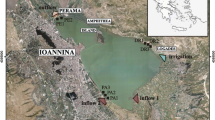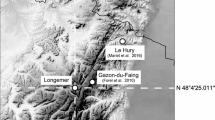Abstract
Lead analyses were performed on sediment cores from seven Connecticut lakes by dilute acid leaching. The absolute concentrations of lead varied from core to core, but the lead profiles were similar in all of the cores, and each depicted a point where the concentration of lead sharply increased above background levels. The background lead concentrations observed in the bottom portions of the cores ranged from 12-54 μg Pb/g sediment with a mean of 30 μg Pb/g, and increased to a mean maximum of 310 μg Pb/g. In six of the lakes significant increases above background levels were not noted until between 1924 and 1952, suggesting that, at least for Connecticut lakes, the point in a lake sediment core where the concentration of lead began to increase was after ca. 1924, and on average about 1930. Lead concentrations declined in the surface sediments of only three of the lakes, mostly since the 1980's, and presumably in response to the phasing out of leaded gasoline. However, significant declines in lead concentrations were not observed in the remaining cores, possibly due to increased motor vehicle use within the airshed of the lakes and/or changes in the export of lead to the lakes from their watersheds.
Similar content being viewed by others
References
Appleby, R. G. & F. Oldfield, 1983. The assessment of 210Pb data from sites with varying sediment accumulation rates. Hydrobiologia 103: 23–35.
Baker, B. G., 1977. Control of noxious emissions from internal combustion engines. In Bockris, J. O'M. (ed.), Environmental Chemistry. Plenum Press, New York, 243–284.
Bell, M., 1985. The face of Connecticut: people, geology, and the land. State Geological and Natural History Survey of Connecticut Bulletin 110.
Binford, M. W., 1990. Calculation and uncertainty analysis of 210Pb dates for PIRLA project lake sediment cores. J. Paleolim. 3: 253–267.
Binford, M. W., J. S. Kahl & S. A. Norton, 1993. Interpretation of 210Pb profiles and verification of the CRS dating model in PIRLA project lake sediment cores. J. Paleolim. 9: 275–296.
Caldwell, J. Personal communication. Environmental Engineer, Fuels and Energy Division, U.S. EPA, Washington, D.C.
Callender, E & P.C. Van Metre, 1997. Reservoir sediment cores show U.S. lead declines. Environ. Sci. Technol. 31: 424A-428A.
Canavan, R. W. IV & P. A. Siver, 1994. Chemical and physical properties of Connecticut lakes with emphasis on regional geology.Lake Reservoir Manag. 10: 173–186.
Canavan, R. W. IV & P. A. Siver, 1995. Connecticut lakes. A study of the chemical and physical properties of fifty-six Connecticut lakes. Connecticut College Arboretum, New London, CT, 299 pp.
Chow, T. J.,K. W. Bruland, K. Bertini, A. Soutar, M. Kolde & E. D. Goldberty, 1973. Lead pollution: Records in southern California coastal sediments. Science 181: 551–552.
Cornett, R. J.,L. Chant & D. Link, 1984. Sedimentation of Pb-210 in Laurential Shield lakes. Wat. Pollut. Res. J. Can. 19: 97–109.
Crecellus, E. A. & D. Z. Piper, 1973. Particulate lead contamination recorded in sedimentary cores from Lake Washington, Seattle. Environ. Sci. Technol. 7: 1053–1055.
Daines, R. H., H. Motto & D. M. Chilko, 1970. Atmospheric lead: Its relationship to traffic volume and proximity to highways.Environ. Sci. Technol. 4: 318–323.
Dillon, P. J. & R. D. Evans, 1982. Whole-lake lead burdens in sediments of lakes in southern Ontario, Canada. Hydrobiologia 91: 121–130.
Edington, D. N. & J. A. Robbins, 1976. Records of lead deposition in Lake Michigan sediments since 1800. Environ. Sci. Technol.10: 266–274.
Eisenreich, S. J., N. A. Metzer, N. R. Urban & J. A. Robbins, 1986. Response of atmospheric lead to decreased use of lead in gasoline. Environ. Sci. Technol. 20: 171–174.
Giblin, A. E., G. E. Likens, D. White & R. W. Howarth, 1990. Sulfur storage and alkalinity generation in New England lake sediments. Limnol. Oceanogr. 35: 852–869.
Glew, J. R., 1988. A portable extruding device for close interval sectioning of unconsolidated core samples. J. Paleolim. 1: 235–239.
Glew, J. R., 1989. A new trigger mechanism for sediment samples. J. Paleolim. 2: 241–243.
Gobell, C., W. K. Johnson, R. W. MacDonald & C. S. Wong, 1995. Sources and burdens of lead in St. Lawrence estuary sediments: Isotopic evidence. Environ. Sci. Tech. 29: 193–201.
Habibi, K., 1973 Characterization of particulate matter in vehicle exhaust. Environ. Sci. Technol. 7: 223.
Hall, S. K., 1972. Pollution and poisoning. Environ. Sci. Technol. 1: 31–35.
Lazrus, A. L., E. Lorange & J. P. Lodge Jr., 1970. Lead and other metal ions in United States precipitation. Environ. Sci. Technol. 4: 55–58.
Miller, E. K. & A. J. Friedland, 1994. Lead migration in forest soils. Response to changing atmospheric inputs. Environ. Sci. Technol. 28: 662–669.
Murozumil M., T. J. Chow & C. C. Patterson, 1969. Chemical compositions of pollutant lead aerosols, terrestrial dusts, and sea salts in Greenland and Antarctic snow strata. Geochim. Cosmochim. Acta 33: 1247–1294.
Ng, A. & C. C. Patterson, 1982. Changes of lead and barium with time in California off-shore basin sediments. Geochim. Cosmochim. Acta 46: 2307–2321.
Norton, S. A., C. T. Hess & R. B. Davis, 1981. Rates of accumulation of heavy metals in pre and post-European sediments in New England lakes. In Eisenreich, S. J. (ed.), Atmospheric Pollutants in Natural Waters. Ann Arbor Scientific Publishers, Ann Arbor, MI, 409–421.
Norton, S. A. & J. S. Kahl, 1987. A comparison of lake sediments and ombotrophic peat deposits as long-term monitors of atmospheric pollution. In Boyle, T. P.(ed.), New Approaches to Monitoring Aquatic Ecosystems ASTM STP 940. American Society for Testing and Materials, Philadelphia, 40–57.
Siver, P. A., R. W. Canavan IV, C. K. Field, L. J. Marsicano & A. Lott, 1996. Historical changes in Connecticut lakes over a fifty-five year period. J. Environ. Quality 25: 334–345.
U.S. Bureau of the Census. Statistical Abstract of the United States, 1935–1995.
U.S. Environmental Protection Agency, 1993. National Air Pollutant Emission Trends, 1900–1992. Office of Air Quality Planning and Standards. EPA/454/R-93/032.
Author information
Authors and Affiliations
Rights and permissions
About this article
Cite this article
Siver, P.A., Wizniak, J.A. Lead analysis of sediment cores from seven Connecticut lakes. Journal of Paleolimnology 26, 1–10 (2001). https://doi.org/10.1023/A:1011131201092
Issue Date:
DOI: https://doi.org/10.1023/A:1011131201092




